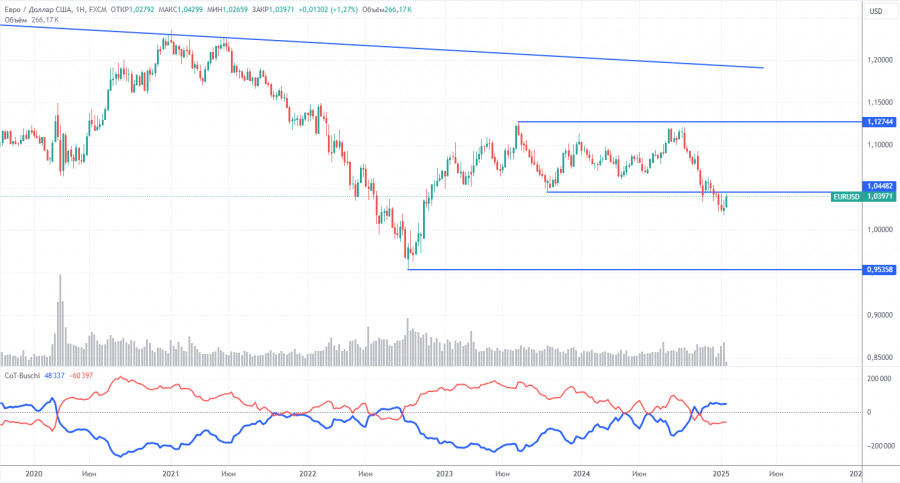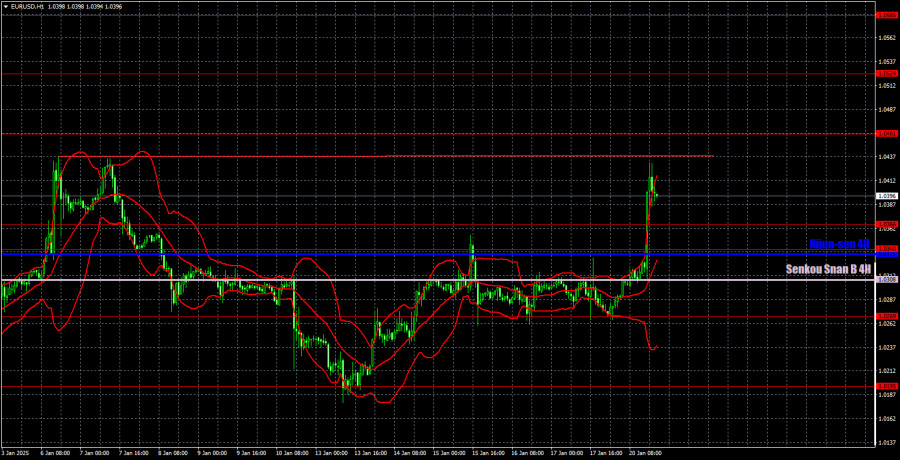

The EUR/USD currency pair saw a rapid increase of nearly 200 pips on Monday. There were no fundamental reasons for such a movement; the market reacted unexpectedly to Trump's inauguration. However, who could have predicted the sell-off of the U.S. dollar? One might consider the standard explanation of "increased risk sentiment in the market." It's important to note that the dollar's decline began well before the inauguration, indicating that it was not a direct result of Trump's speech. He has reiterated his plans to reshape America and the world numerous times, so nothing particularly surprising or new occurred throughout the day—just market sentiments at play.
We believe that this movement was not merely due to market emotions but rather simple profit-taking after four months of short positions. The market had been selling off the pair for an extended period, and the timing conveniently aligned profit-taking with a significant event. To emphasize, we do not think the dollar's decline was linked to Trump's inauguration. Just as quickly as the dollar fell, it could also return to its previous levels. Last week, the market largely ignored all macroeconomic and fundamental factors that support the U.S. currency. Global conditions still favor the dollar, and there were no substantial reasons for the plunge on Monday.
That said, significant trading opportunities arose during this period. During the European session, the price broke through the Senkou Span B line, enabling traders to open long positions. The pair then increased by at least 100 pips. Traders could close their positions at various points along the way and still have made a profit.

The latest COT report, dated January 14, indicates that the net position of non-commercial traders has consistently leaned towards a bullish stance. However, bears have recently taken the lead. Two months ago, there was a significant increase in the number of open short positions held by professional traders, resulting in a net position that turned negative for the first time in a considerable period. This suggests that the euro is being sold more frequently than it is being purchased.
Currently, we do not observe any fundamental factors that could support a strengthening of the euro. Technical analysis consistently shows that the price has remained in a consolidation zone, essentially demonstrating a flat trend. On the weekly timeframe, it is evident that since December 2022, the pair has fluctuated between the levels of 1.0448 and 1.1274. However, breaking below the 1.0448 level has opened up new opportunities for further decline.
At present, the red and blue lines have crossed and reversed their positions concerning each other, signaling a bearish trend in the market. During the last reporting week, the number of long positions in the "Non-commercial" category decreased by 3,700 contracts, while short positions dropped by 7,400 contracts. Consequently, the net position increased slightly by 3,700 contracts.

On the hourly time frame, the currency pair has been in a downward trend for over three months. We believe this decline will continue in the medium term. The Federal Reserve is expected to reduce interest rates only 1-2 times in 2025, which is a more hawkish stance than the market had anticipated. This factor, among others, will continue to support the U.S. dollar. Currently, a technical correction is underway, but it is unlikely to last long.
For January 21, the following levels are notable for trading: 1.0124, 1.0195, 1.0269, 1.0340-1.0366, 1.0461, 1.0524, 1.0585, 1.0658-1.0669, 1.0757, 1.0797, and 1.0843. Additionally, the Senkou Span B (1.0308) and Kijun-sen (1.0335) lines should be monitored, as the Ichimoku indicator lines may shift throughout the day. It's important to set Stop Loss orders at breakeven if the price moves 15 pips in the desired direction to safeguard against potential losses in the event of a false signal.
On Tuesday, no significant events or reports are scheduled in the Eurozone. In the U.S., the Producer Price Index (PPI) will be released, but this is considered a secondary indicator. The market is likely to stabilize and return to normal. The dollar may start to recover, but traders should primarily pay attention to technical signals.

ĐƯỜNG DẪN NHANH